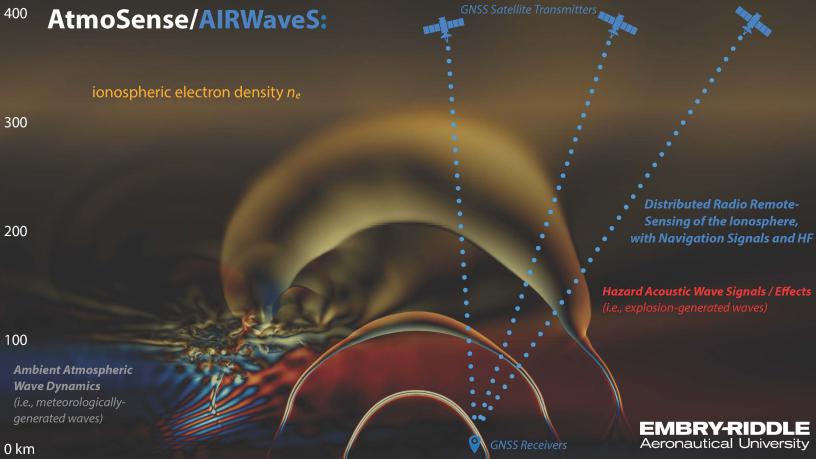AtmoSense, which began in late 2020, set out to understand the fundamentals of energy propagation from the Earth’s surface to the ionosphere to determine whether the atmosphere can be used as a sensor. A fundamental science effort, AtmoSense aimed to measure acoustic and electromagnetic waves propagating through the atmosphere to see if they could provide clues about the nature, location, and size of a disturbance event that occurred on Earth. Precisely locating illicit underground explosions by a rogue nation or identifying other national security-relevant events could be done in the future just by using signals detected and modeled from the atmosphere. The open-source tools developed under AtmoSense may be the first step toward “reading” — from extended distances — information contained in atmospheric waves propagating from an event happening anywhere in the world.
Benefits for a range of computationally complex problems
“High-resolution surface-to-space simulation of acoustic waves was considered impossible before the program began, but we accomplished it,” said Michael “Orbit” Nayak, DARPA AtmoSense program manager. “We used to call the ionosphere the ‘ignorosphere,’ but AtmoSense made some key interdisciplinary breakthroughs to address what used to be a massively intractable problem. We can now model across six orders of magnitude, in 3D, what happens to the energy emanating from a small, meters-scale disturbance as it expands up into the atmosphere to propagate over thousands of kilometers, and potentially around the world.”
[…]
An unplanned discovery: SpaceX Falcon 9 re-entries detected
Following one of the New Mexico test-range detonations in 2024, a performer team noticed something unusual in their analysis of sensor data.
“As the team was looking at the data, they saw a huge drop in what’s called total electron content that puzzled them,” Nayak said. “Imagine that you have water going through a hose. That’s a flow of electrons, and if you put your fist in front of the hose, you’ll notice a significant drop in water volume coming out of the hose.”
In preparing to analyze their field test data, the team noticed a similar sizable dip in the electron content compared to the background electron readings at a specific location in the atmosphere. As they did more forensics, they correlated the disturbance to a SpaceX Falcon 9 re-entry that happened the same day of the detonation test. Their sensor data had unexpectedly captured the SpaceX reentry into the atmosphere, resulting in the specific drop in electron content.
“Then they decided to pull other SpaceX reentry data, across dozens of launches, to see if they could spot a similar electron drop,” Nayak said. “The phenomenon is highly repeatable. We discovered an unplanned new technique for identifying objects entering the earth’s atmosphere.” The Embry-Riddle University team, led by Jonathan Snively and Matt Zettergren, in collaboration with Pavel Inchin of Computational Physics, Inc., have submitted their novel results for peer-reviewed publication.
[…]
Source: Using the Earth’s atmosphere as a global sensor shows promise | DARPA

Robin Edgar
Organisational Structures | Technology and Science | Military, IT and Lifestyle consultancy | Social, Broadcast & Cross Media | Flying aircraft

